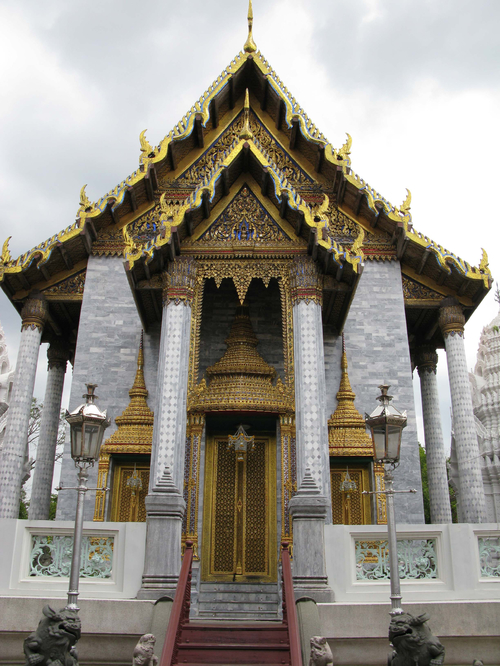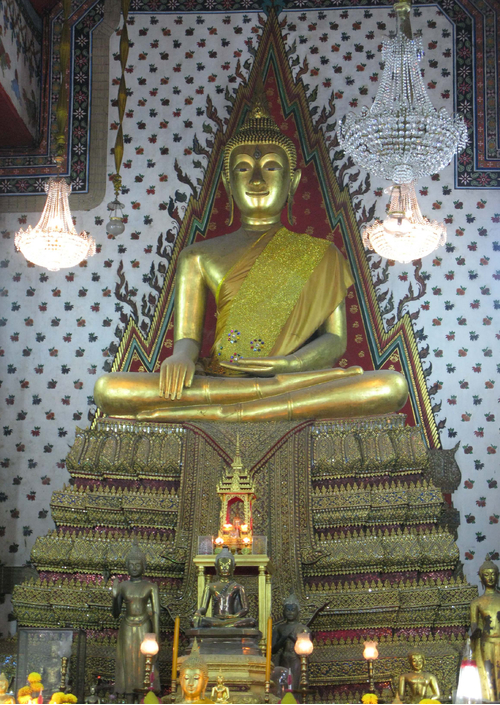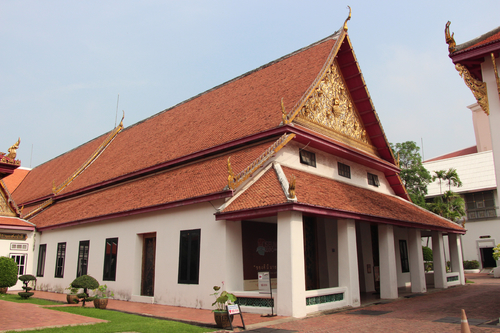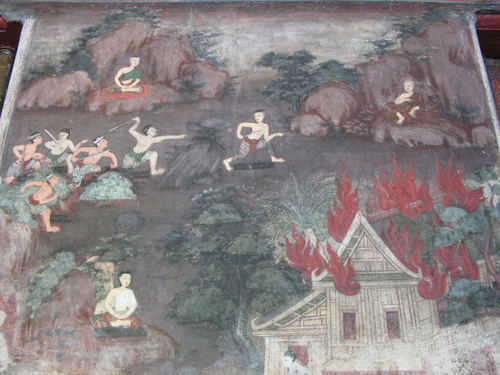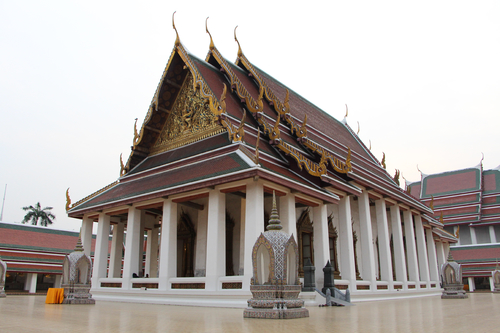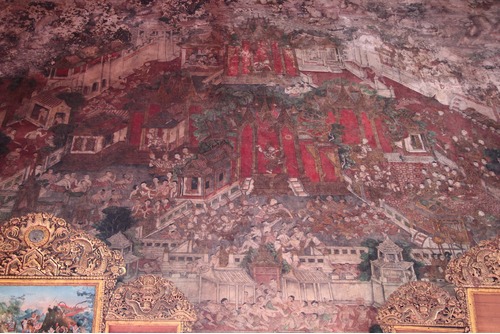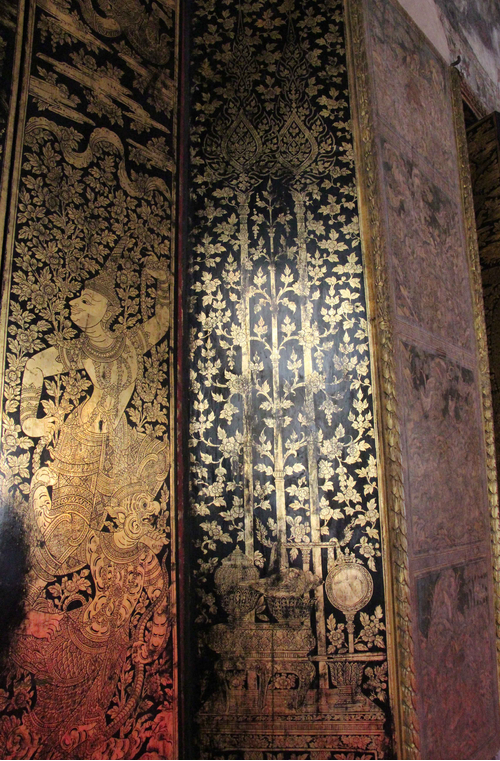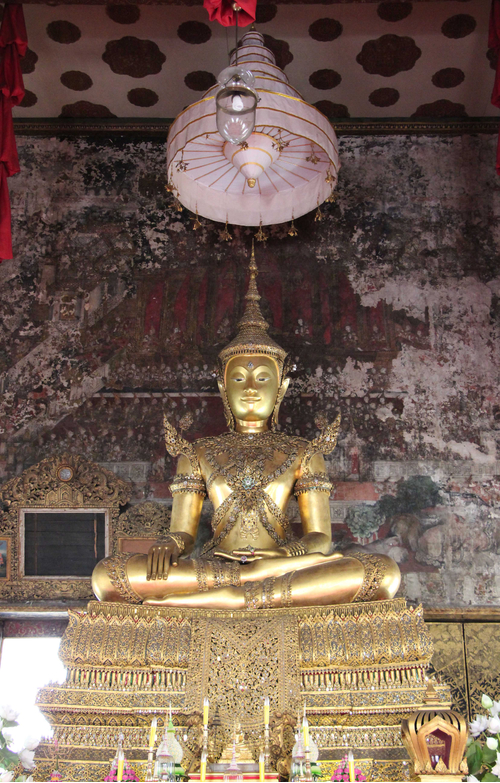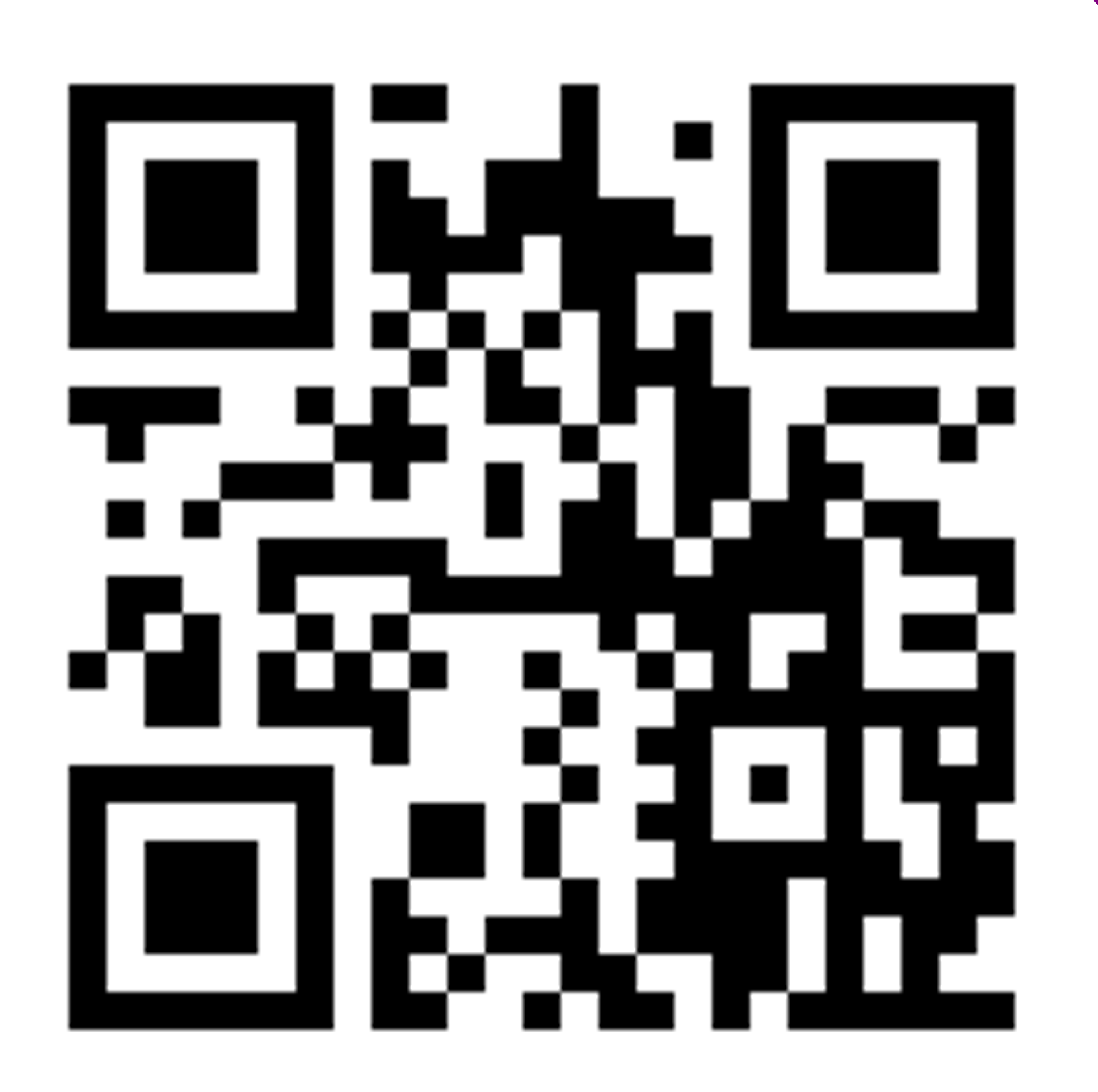ค้นหางานศิลปกรรม
ฐานข้อมูลศิลปกรรมในเอเชียตะวันออกเฉียงใต้
สถาปัตยกรรมวัดราชประดิษฐสถิตมหาสีมาราม
ภายในวัดราชประดิษฐสถิตมหาสีมารามมีสถาปัตยกรรมที่สำคัญหลายแห่ง แบ่งเป็นพื้นที่เขตพุทธาวาสและสังฆาวาส ในส่วนพุทธาวาสมีอาคารสำคัญ ได้แก่ พระวิหารหลวงที่มีรูปแบบอย่างไทยประเพณี ตัวอาคารประดับด้วยหินอ่อน หลังคาเครื่องไม้มุงกระเบื้องประดับเครื่องลำยอง หน้าบันเป็นรูปพระมหามงกุฎและพระขรรค์ประดิษฐานบนพานแว่นฟ้า เบื้องล่างมีรูปช้างสำคัญ ขนาบด้วยฉัตร เบื้องหลังพระวิหารหลวงเป็นที่ตั้งของ ปาสาณเจดีย์ ซึ่งเป็นเจดีย์ประธานของวัด มีรูปแบบเป็นเจดีย์ทรงระฆังแบบพระราชนิยมในรัชกาลที่ 4 สร้างจากหินอ่อน นอกจากนี้ยังมีอาคารสำคัญอื่นอีก เช่น หอพระจอม รูปแบบและแผนผังของวัดที่มีองค์ประกอบหลักอย่างเรียบง่ายคือพระวิหารและพระเจดีย์เช่นนี้ พบได้ในวัดที่สร้างขึ้นตามพระราชประสงค์ของรัชกาลที่ 4 ส่วนเขตสังฆาวาสของวัดนี้ซึ่งเป็นที่อยู่ของสงฆ์นั้นมีข้อกำหนดไว้ว่าเป็นเขตหวงห้ามสำหรับสตรี
ประติมากรรมพระพุทธชัมภูนุทมหาบุรุษลักขณาอสีตยานุบพิตร
พระพุทธชัมภูนุทมหาบุรุษลักขณาอสีตยานุบพิตรมีรูปแบบเฉพาะอย่างพระพุทธรูปที่สร้างในสมัยรัชกาลที่ 3 กล่าวคือ พระวรกายค่อนข้างเพรียว พระพักตร์ค่อนข้างกลมกึ่งรูปไข่ ขมวดพระเกศาเล็ก พระรัศมีเป็นเปลว พระขนงโก่ง เส้นขอบเปลือกพระเนตรและพระขนงป้ายเป็นแผ่นเช่นเดียวกับพระพุทธรูปอยุธยาตอนปลาย พระเนตรเปิดและมองตรง พระนาสิกค่อนข้างเล็กและโด่ง พระโอษฐ์เล็ก เส้นพระโอษฐ์อ่อนโค้งเล็กน้อยเกือบเป็นเส้นตรง คล้ายเรือประทุน พระพักตร์อย่างหุ่น ประทับนั่งแสดงปางมารวิชัย นิ้วพระหัตถ์เรียวยาวเสมอกัน สังฆาฏิเป็นแผ่นใหญ่พาดอยู่กึ่งกลางพระวรกาย
สถาปัตยกรรมพระที่นั่งอิศราวินิจฉัย
พระที่นั่งอิศราวินิจฉัยเป็นอาคารโรง ก่ออิฐถือปูน ชั้นเดียว ขนาด 10 ห้อง หันหน้าไปทางทิศตะวันออก ฝากั้นทึบทั้ง 4 ด้าน ด้านหน้ามีระเบียง เสาระเบียงและเสาในอาคารเป็นเสาสี่เหลี่ยมขนาดใหญ่แบบที่นิยมในสมัยรัชกาลที่ 3 ภายในประดิษฐานพระที่นั่งบุษบกมาลา หลังคาพระที่นั่งประดับด้วยเครื่องไม้มุงกระเบื้องดินเผาไม่เคลือบสี ประดับกรอบหน้าบันด้วยช่อฟ้า ใบระกา หางหงส์ หน้าบันประดับรูปเทพนมประทับบนฐานบัวแกมช่อกระหนกเปลว ปิดทองประดับกระจก
จิตรกรรมจิตรกรรมเรื่องวิปัสสนาญาณ
จิตรกรรมเรื่องวิปัสสนาญาณเขียนอยู่ที่ผนังระหว่างช่องหน้าต่าง ด้านซ้ายของพระพุทธรูปประธาน ฉากหลังเป็นภาพแนวป่าไม้โขดหินสีโทนน้ำตาล ซึ่งมีภาพบุคคล ได้แก่ ภิกษุ ชาวบ้าน อยู่ในอิริยาบถต่างๆ แต่งกายตามสมัยนิยม โดยผู้ชายนุ่งผ้าโจง มีผ้าคาดเอว ผู้หญิงนุ่งผ้า ห่มสไบ สีผิวออกขาวนวลโดยไล่สีอ่อนแก่แตกต่างกันในแต่ละบุคคล การเขียนภาพแม้จะเริ่มมีการแรเงาบ้างแล้ว แต่ยังขาดมิติตามหลักทัศนียวิทยา เช่นเดียวกับงานจิตรกรรมไทยประเพณีในสมัยก่อนมีข้อความที่เขียนอธิบายสั้นๆ ใต้ภาพบุคคลบางแห่ง มีทั้งชื่อญาณและกิเลสประเภทต่างๆ
สถาปัตยกรรมวัดสระเกศ
พระอุโบสถเป็นอาคารแบบไทยประเพณี หลังคาเครื่องไม้ซ้อนชั้น ประดับเครื่องลำยอง ประกอบด้วยช่อฟ้า ใบระกา นาคสะดุ้ง หางหงส์ หน้าบันประดับรูปพระนารายณ์ทรงครุฑทำด้วยไม้แกะสลักปิดทองประดับกระจก ซุ้มประตูหน้าต่างทรงบันแถลง มีเสาพาไลโดยรอบพระอุโบสถ พนักระเบียงรอบพระอุโบสถประดับกระเบื้องปรุ มีซุ้มสีมาทรงกูบทั้ง 8 ทิศประดับกระเบื้องเคลือบสีที่สั่งทำจากประเทศจีน พระอุโบสถล้อมรอบด้วยระเบียงคดที่ประดิษฐานพระพุทธรูปนั่งเรียงรายทั้ง 4 ด้าน
จิตรกรรมจิตรกรรมเรื่องชมพูบดี
จิตรกรรมมีสภาพค่อนข้างลบเลือน ผนังด้านตรงข้ามพระประธานเขียนตอนพระอินทร์จำแลงกายมาเป็นทูตเชิญเสด็จพระเจ้าชมพูบดีไปยังเวฬุวัน ผนังด้านทิศเหนือเขียนตอนกระบวนเสด็จของพระเจ้าชมพูบดี ผนังด้านหลังพระประธานเขียนตอนพระเจ้าชมพูบดีเข้าเฝ้าพระพุทธเจ้า ผนังด้านทิศใต้เขียนตอนกระบวนเสด็จของกาญจนราชเทวีพระมเหสี จิตรกรรมฝาผนังมีรูปแบบและเทคนิคอย่างจิตรกรรมไทยประเพณีในสมัยรัชกาลที่ 3 โดยตัวละครแสดงกิริยาอย่างนาฏลักษณ์ พื้นหลังฉากปราสาทใช้สีแดงชาด คั่นฉากเหตุการณ์สำคัญด้วยกำแพงเมือง แนวพุ่มไม้ หรือโขดหิน ภาพปราสาทราชวังยังคงเป็นแบบไทยประเพณี ในขณะที่ภาพอาคารบ้านเรือนมีการจำลองภาพอาคารตามสมัยนิยม
จิตรกรรมลายรดน้ำเครื่องราชูปโภค
จิตรกรรมลายรดน้ำที่บานแผละประตูและหน้าต่างภายในพระอุโบสถวัดนางนองมีทั้งหมด 28 ภาพ เขียนภาพเครื่องราชูปโภค เครื่องราชกกุธภัณฑ์ เครื่องยศ เครื่องสิริมงคล เครื่องศัตราวุธ เครื่องดนตรีที่ใช้ประกอบพระราชพิธีต่างๆ โดยมีภาพเครื่องสูง ได้แก่ ฉัตร บังสูรย์ บังแทรก ประกอบอยู่เบื้องหลัง ลวดลายทั้งหมดปิดทองคำเปลวบนพื้นรักสีดำ
ประติมากรรมพระพุทธมหาจักรพรรดิ
พระพุทธรูปประทับนั่งขัดสมาธิราบ แสดงปางมารวิชัย พระวรกายเพรียว พระพักตร์ค่อนข้างกลมกึ่งรูปไข่ พระขนงโก่ง พระเนตรเรียวเล็ก พระโอษฐ์อ่อนโค้งเล็กน้อยจนเกือบเป็นเส้นตรง พระพักตร์คล้ายหุ่น อันเป็นรูปแบบเฉพาะของพระพุทธรูปในรัชกาลที่ 3 ทรงเครื่องประดับต่างๆ ได้แก่ พระมหามงกุฎ กรองศอ สังวาล พาหุรัด ทองพระกร ทองพระบาท
